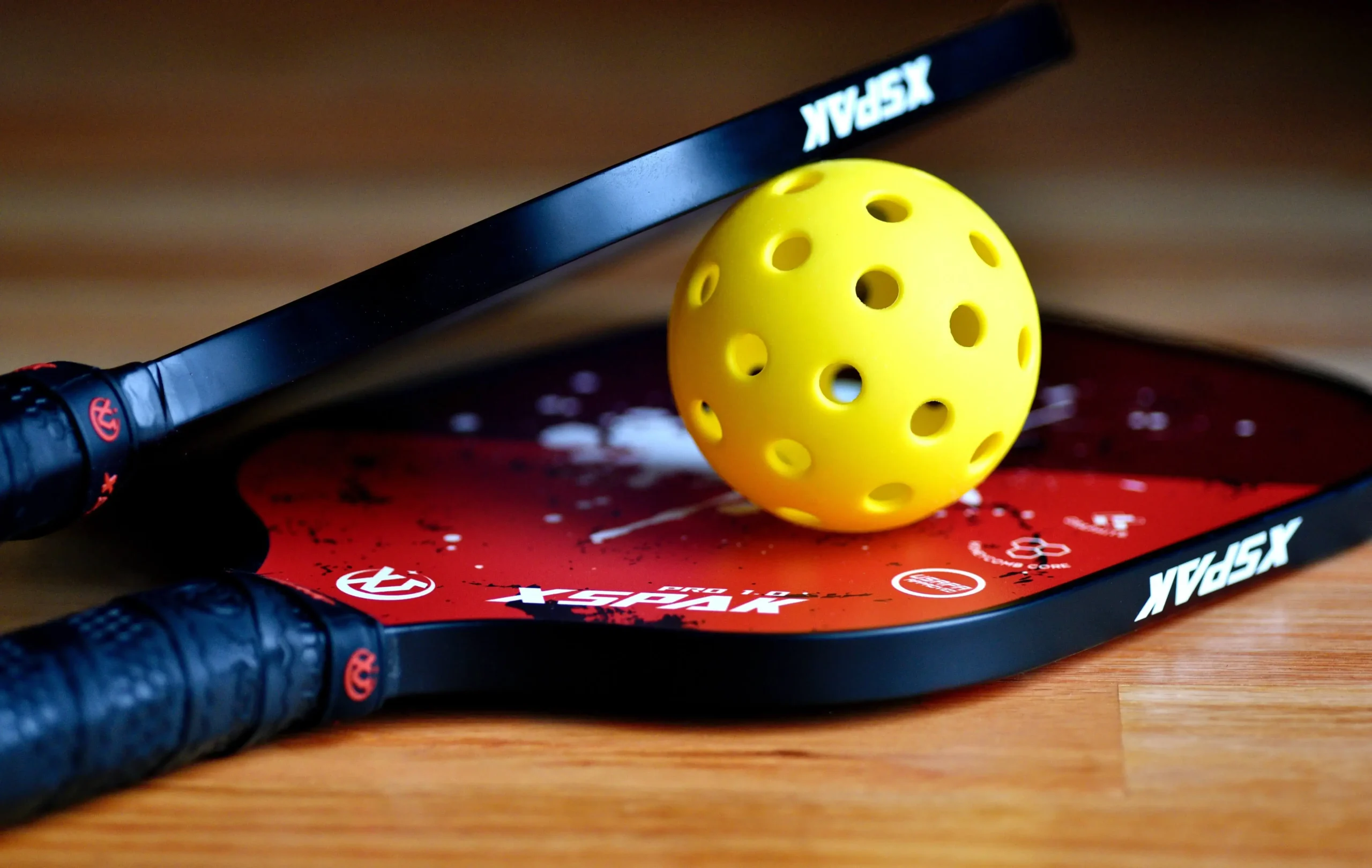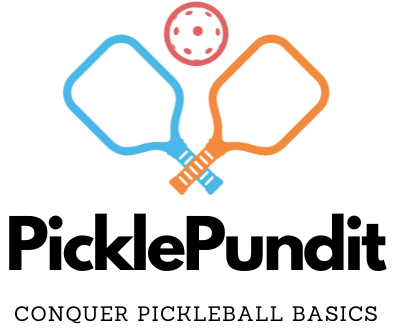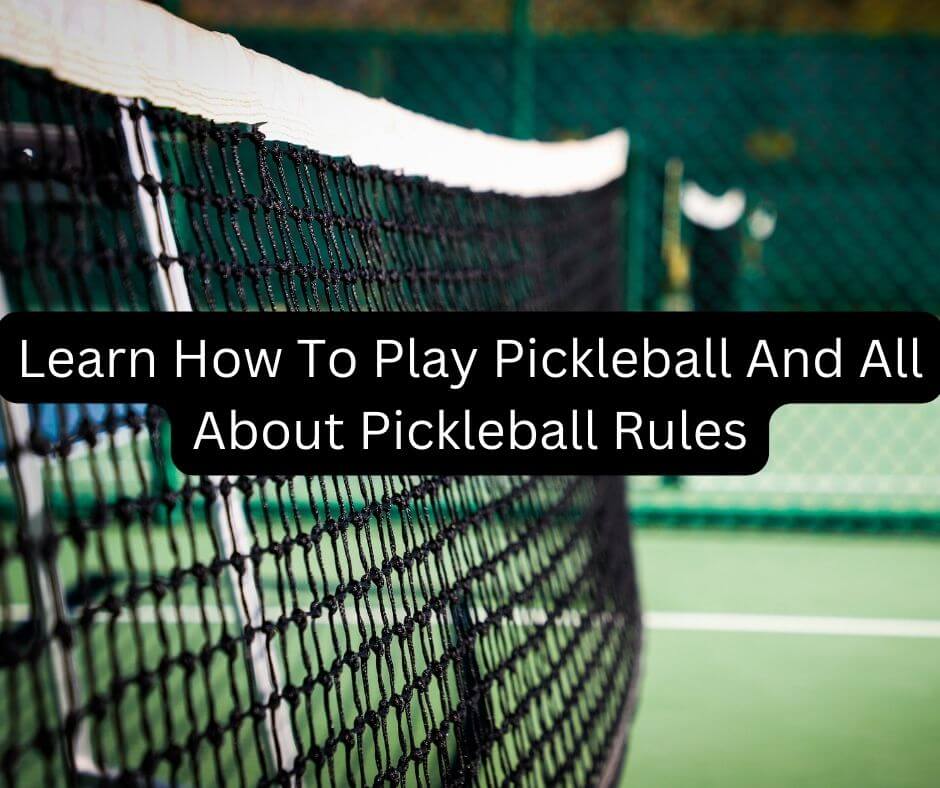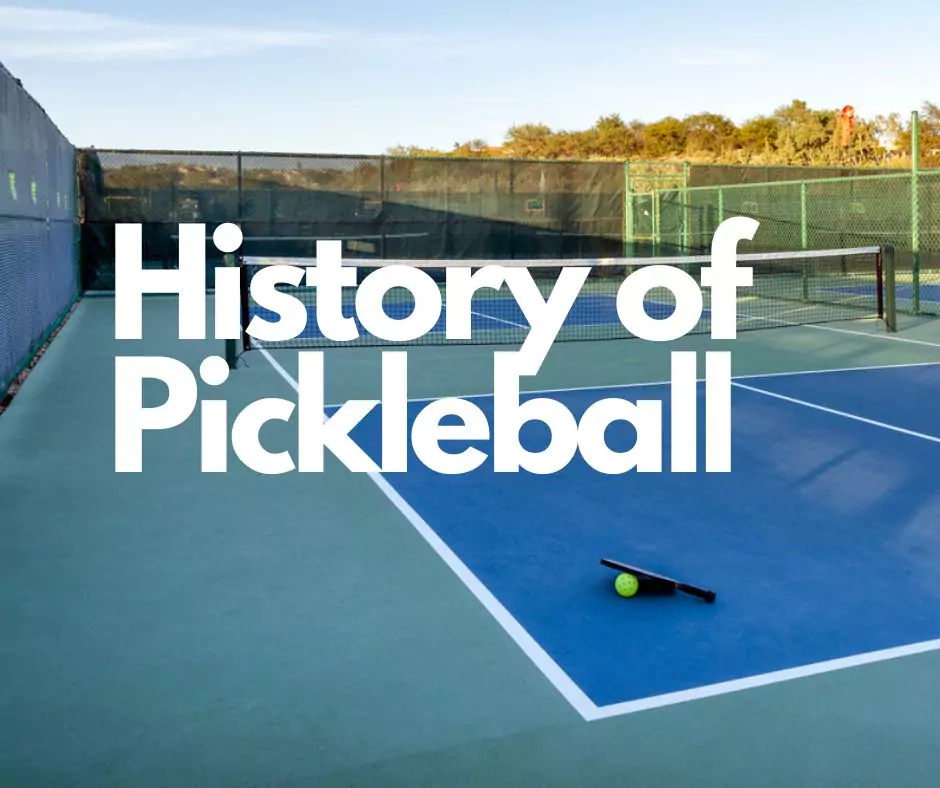Hey there! Are you new to pickleball? No worries, I’ve got you covered. By the end of this article, you’ll learn how to play pickleball like the pros!
In this article, we’ll dive deep into pickleball and explore everything you need to know about the game and its rules.
Pickleball is an exciting sport that combines elements of tennis, badminton, and ping pong. It’s played with a paddle and a plastic ball on a court that resembles a miniature tennis court. But don’t let its size fool you – pickleball packs a punch when it comes to fun and excitement!
I’ll take you through the basic rules of pickleball, including scoring and gameplay. We’ll also explore the different styles of play – singles versus doubles – so you can choose what suits your preferences best.
Additionally, I’ll provide a detailed look at the pickleball court and share some advanced strategies to help elevate your game.
And let’s not forget about equipment! I’ll give tips on selecting the best paddles for your skill level.
So if you’re ready to embark on this thrilling journey into pickleball, let’s get started!
Table of Contents
TL:DR
- Pickleball is a sport that combines elements of tennis, badminton, and ping pong.
- The game is played with a paddle and a plastic ball on a miniature tennis court.
- There are two styles of play: singles and doubles.
- The bounce rule is crucial in pickleball, as the ball must bounce once on each side before being volleyed or hit in the air.
What is Pickleball
Pickleball is a super fun and addictive sport that combines elements of tennis, badminton, and ping pong.
If you’re new to pickleball and want to learn how to play, you’ve come to the right place!
Pickleball is a game played with a paddle and a plastic ball on a court, similar to a tennis court.
The basic rules are simple: serve underhand, let the ball bounce once on each side before hitting it back over the net, and stay out of the non-volley zone near the net.
As you get more comfortable with pickleball, you can start incorporating different strategies into your gameplay.
Remember, pickleball rules bring freedom and enjoyment to players of all skill levels.
So grab a paddle, and let’s dive into this exciting sport!
Understanding the Basic Pickleball Rules
When learning the basic rules of pickleball, it’s essential to understand the rules regarding the bounce.
In pickleball, each team must wait for the ball to bounce once on their side before they can volley or hit it in the air.
This rule ensures fair play and allows players to have a chance to return shots effectively.
Remembering this rule and practicing proper timing during gameplay to excel at pickleball is crucial.
Specific Rule in Pickleball: The Bounce
With a swift bounce off the paddle, the ball soars over the net, creating an exhilarating moment in the game. In pickleball, understanding the bounce rules is crucial for success on the court.
Here are five key points to help you grasp this concept:
- The serve: When serving the ball, it must be hit underhand and make contact with the paddle below waist level.
- The ball must bounce: After being served, both teams must let it bounce once before returning it. This ensures fairness and allows everyone a chance to react.
- Diagonal bound: During play, each returned shot must first land within bounds diagonally across from where it was hit. This keeps players on their toes and adds an exciting element to the strategy.
- Points in play: Once both teams have successfully returned shots after the initial bounce, the ball remains in play until a point is scored or a fault occurs.
- Freedom of movement: Understanding these rules allows you to explore different techniques and tactics while enjoying this dynamic sport.
Remember, mastering the art of controlling bounces will greatly enhance your pickleball experience.
Pickleball Scoring Explained
Discover the exhilarating feeling of scoring points in pickleball and let the joy of victory fuel your passion for this addictive sport. In pickleball, scoring is straightforward to understand. The game can be played in both doubles and singles, with each player using a paddle to hit the ball over the net onto the opponent’s side of the court.
To score a point in pickleball, you must be serving. The serving team can only score when they win a rally. A rally is won if the opposing team commits a fault or fails to return the ball properly. The serving team continues to serve until they commit a fault themselves.
A 2-column and 5-row table is commonly used to keep track of the score. Each column represents one team, and each row represents one point scored. This visual aid makes it easy to see who leads the game.
Scoring in pickleball adds an extra level of excitement to an already thrilling sport. Whether you’re playing doubles or singles, understanding how points are scored will enhance your overall experience on the court. So grab your paddle and dive into this exciting world of pickleball!
How to Play Pickleball
When it comes to playing pickleball, two key points to remember are using the paddle effectively and understanding the importance of the bounce. As a player, I’ve learned that the paddle isn’t just a tool but an extension of my arm that helps me control the ball and execute different shots.
Additionally, mastering the art of reading the bounce is crucial for positioning me correctly on the court and anticipating my opponent’s next move. I can improve my overall gameplay and become a more skilled pickleball player by focusing on these aspects.
Using the Pickleball Paddle
Using the pickleball paddle will make you feel like a pro on the court. It’s an essential tool for playing pickleball, and mastering its use is crucial to your success in the game.
Here are four key things to keep in mind when using the pickleball paddle:
- Grip: Hold the paddle with a firm but relaxed grip, allowing flexibility and control.
- Swing: Use a smooth and controlled swing motion when hitting the ball, aiming for accuracy rather than power.
- Positioning: Maintain proper positioning on the court to ensure you’re always ready to hit the ball, whether playing singles or doubles.
- Faults: Be aware of common faults, such as stepping into the non-volley zone during volleys or hitting balls out of bounds.
By following these guidelines and familiarizing yourself with pickleball rules, you’ll be able to confidently navigate any service court situation and excel in both singles and doubles play.
Have fun exploring all that this exciting sport has to offer!
Importance of the Bounce in Pickleball
Transition: Now that you understand how to use the pickleball paddle, let’s dive into the importance of the bounce in pickleball.
When playing pickleball, the bounce is crucial in determining whether a shot is valid. According to the official rules, every ball must bounce once on each side before players can hit it out of the air. This ensures fair play and gives both teams an equal opportunity to return shots.
Understanding these measurements will enable you to position yourself correctly on the court and anticipate where the ball will land after its initial bounce. Remember, mastering the art of controlling bounces will significantly improve your gameplay and make you a formidable opponent in both singles and doubles matches. So keep practicing and get ready to rule the court!

Singles and Doubles: Pickleball Strategy Simplified
When it comes to pickleball, understanding the differences between single and double play is crucial.
In singles play, strategies revolve around covering the entire court and exploiting the opponent’s weaknesses.
On the other hand, in doubles play, teamwork and communication are key as you work together with your partner to control the middle of the court and set up winning shots.
By recognizing these distinctions, players can adapt their game plan accordingly and increase their chances of success on the pickleball court.
Strategy for Pickleball Singles
Mastering the art of pickleball singles requires clever footwork, strategic shot placement, and a relentless determination to outmaneuver your opponent. In this fast-paced game, it’s essential to understand the unique strategy of playing singles. Here are five key elements to consider when honing your skills on the court:
- Positioning: Be mindful of your court coverage, always staying in a position that allows you to react and reach any shot quickly.
- Serve Placement: Use different serving strategies to keep your opponent off balance and force them into difficult returns.
- Shot Selection: Choose shots wisely, aiming for the corners and sidelines to make it harder for your opponent to return.
- Aggressive Net Play: Take advantage of opportunities to move forward and pressure your opponent by volleying or smashing at the net.
- Court Awareness: Stay alert and adapt quickly to changes in momentum or positioning.
You’ll be well-equipped to excel in pickleball singles play by mastering these elements. Whether you’re new to the sport or looking to improve your game, understanding these strategies will help you become a formidable player.
Strategy for Pickleball Doubles
Effective communication, strategic positioning, and mastery of game elements like serving and volleying can significantly improve a team’s performance in pickleball doubles play.
- Doubles players must anticipate each other’s movements and communicate effectively to excel on the pickleball court.
- Strategy is crucial in doubles play, with positioning on the court being a key aspect.
- Strategic court positioning covers more ground and reduces the opponent’s scoring opportunities.
- Clear communication enhances coordination and minimizes confusion during gameplay.
- Knowledge of the rules and strategies for serving in doubles can be advantageous.
- Mastering volleys helps to maintain control of the ball during fast-paced exchanges with opponents.
- Implementing these strategies and effective communication can improve performance and increase winning chances.
Understanding Singles and Doubles Differences
Understanding the differences between singles and doubles in pickleball can greatly enhance your gameplay and strategic approach.
In singles, you’re the sole player on your side of the court, which means you have more space to cover and greater responsibility for every shot. The non-volley zone (also known as the kitchen) becomes even more crucial in singles, as volleys aren’t allowed if you’re inside this area. Additionally, positioning is key in singles. You want to stay behind the baseline as much as possible to maximize your chances of returning shots effectively.
On the other hand, in doubles, you have a partner who can help cover more ground and communicate with you during play. The right side of the court is typically reserved for your partner’s shots, while staying behind the baseline allows room for teamwork.
Remember, whether playing singles or doubles, the goal remains: win by scoring points through well-executed shots and intelligent strategies.
Detailed Look at the Pickleball Court
The dimensions of a pickleball court are crucial to understanding the game. The court is 20 feet wide and 44 feet long, with the kitchen area that extends 7 feet from the net on either side.
This specific layout ensures fair play and provides players with strategic opportunities.
Pickleball Court Dimensions
The pickleball court is 20 feet wide and 44 feet long, slightly smaller than a tennis court. The net is placed in the middle, dividing the court into two halves.
Each side of the court has a non-volley zone, also known as the kitchen, which extends 7 feet from the net. The height of the net at its center is 34 inches.
When playing pickleball, it’s important to know that the ball must bounce once on each side before players can volley it in the air.
Scoring in pickleball follows a rally scoring system, where points can be scored only when serving.
So make sure to master your serve and get ready for an exciting game on this fast-paced and dynamic court!
Tips for Selecting the Best Pickleball Paddles
Choosing the right pickleball paddle can greatly impact your game and elevate your skill level. Here are three tips to help you select the best paddle for your playing style:
Weight
Consider the weight of the paddle. Lighter paddles offer more control and maneuverability, while heavier ones provide power and stability. Choose a weight that suits your strength and preference.
Grip Size
The grip size is crucial for comfort and control during gameplay. A paddle with a grip that’s too small may cause hand fatigue, while one that’s too large can hinder wrist action. Find a grip size that feels comfortable in your hand.
Material
Pickleball paddles come in various materials, such as wood, composite, or graphite. Wood paddles offer durability but are heavier, while composite and graphite paddles provide better power and control but may be more expensive. Consider your budget and playing style when choosing the material.
Remember, selecting the right pickleball paddle will enhance your ability to volley the ball effectively on a badminton court, score points without hitting the ball out of bounds, understand pickleball scoring rules, serve well, and compete in pickleball tournaments where players may showcase their skills!
Conclusion and final thoughts
I hope this article has given you a comprehensive understanding of pickleball and its rules. Learning the basics is essential whether you’re new to the sport or looking to improve your skills.
Every detail matters in this exciting game, from understanding scoring to selecting the right paddle. Remember to practice regularly and explore advanced strategies to elevate your gameplay.
So grab a paddle, step onto the court, and enjoy the thrill of pickleball!
Pickleball Basics FAQs:
What is pickleball?
Pickleball is a game that combines elements of tennis, badminton, and ping pong. It is played with a paddle and a plastic ball on a tennis-sized court.
How is pickleball played?
Pickleball is played with either singles or doubles, where two or four players are divided into two teams on opposite sides of the net. The objective is to hit the ball over the net and into the opponent’s court while following the game’s rules.
What are the rules in pickleball?
The rules in pickleball include the following: the ball must be served diagonally, the ball must bounce once on each side before being volleyed, and the serving team can only score a point.
What are the court dimensions in pickleball?
The court dimensions in pickleball are the same as a doubles badminton court, which is 20 feet wide and 44 feet long (including the lines).
How many points are needed to win a game of pickleball?
In pickleball, a game is played to 11 points. However, the team must win by at least 2 points.
How does the serve work in pickleball?
The serve in pickleball must be hit underhand and diagonally. The serving team must stand behind the baseline and serve the ball to the opposite diagonal court.
What is the height of the net in pickleball?
The pickleball net is 36 inches high at the center and 34 inches high at the ends.
What happens when the ball hits the net in pickleball?
It is considered a good serve if the ball hits the net but still lands in the proper service court. However, if the ball fails to clear the net, it is considered a fault, and the server gets a second attempt.
Can pickleball be played indoors?
Yes, pickleball can be played both indoors and outdoors. However, the court dimensions and rules remain the same.
Where can I find pickleball courts near me?
To find pickleball courts near you, you can check with local community centers or sports clubs or search online for pickleball facilities in your area. You can also contact the USA Pickleball Association for more information.



Leave a Reply